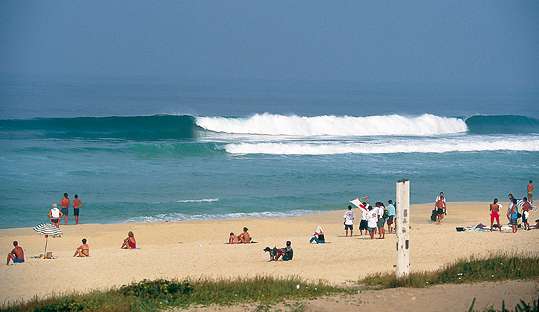Stormrider Guide to surfing Rio de Janeiro
Brazil, SOUTH AMERICA
|
 Barra de Tijuca, John Callahan
Barra de Tijuca, John Callahan
|
Summary
|
+ Brazil's best beachbreaks
|
- Lack of points and reefs
|
|
+ Consistent year-round
|
- Rare epic conditions
|
|
+ Drier winter time
|
- Ultra-crowded main spots
|
|
+ Buzios/cabo frio options
|
- High street-crime rate
|
|
|
Rio’s physical features are dominated by the Sierra do Mar mountain range, which is cloaked by the Mata Atlantica forest. Mountains plunge into the sea, forests meet the beaches, and cliff faces rise abruptly from the extended lowlands. This combination forms the landscape of rare beauty that has made Rio famous as the Wonderful City “Cidade Maravilhosa”. It’s one of the most densely populated places on earth, with seven million “Cariocas” indulging in dancing, drinking, beach-going and sunbathing. The low coastline has been deeply altered by years of earthwork and has several offshore islands in the background.
When to Go
The littoral ‘carioca’ is well exposed to the frequent S-SE Antarctica swells (April-Oct), providing 2-10ft (0.6-3m) conditions most of the time. Expect unusual late-winter E swells produced by lows tracking way off the coast or by major highs blowing strong E winds which send short ENE groundswells. Swells rarely get big which is convenient because few spots seem to hold size. Dominant wind comes from the E varying from 16% (June) to 32% (Oct); NE-SE is the usual direction while winters seem to produce more SW-S winds when cold fronts move towards the coast. Offshores only occur on calm mornings before 10am when the E seabreeze picks up or on SW spots with NE winds. The good news is that tidal range is really low and doesn’t matter most on the time. Grab a ‘tabua de mares’ for better understanding.
Surf Spots
Statistics |
J
|
F
|
M
|
A
|
M
|
J
|
J
|
A
|
S
|
O
|
N
|
D
|
| dominant swell |
E -S |
E -S |
E -S |
E -S |
E -S |
E -S |
| swell size (ft) |
2 |
2-3 |
3-4 |
4 |
3-4 |
2 |
| consistency (%) |
50 |
60 |
80 |
90 |
80 |
50 |
| dominant wind |
NE -E |
NE -E |
NE -E |
NE -E |
NE -E |
NE -SE |
| average force |
F3-F4 |
F3-F4 |
F3-F4 |
F3-F4 |
F4 |
F3-F4 |
| consistency (%) |
67 |
46 |
39 |
48 |
47 |
60 |
| water temp (C) |
25 |
25 |
23 |
22 |
22 |
23 |
| wetsuit |
boardshorts |
boardshorts |
springsuit |
springsuit |
springsuit |
springsuit |
|
Travel Information
Weather
Rio is tropical, warm and humid, with local variations, due to differences in altitude, vegetation and proximity to the ocean; the average annual temp is 22°C/72°F, with daily averages higher in summer from 30-32°C (86-90°F); rains vary from an annual 1,200 to 2,800mm (48-110”in). It can also be dreadfully humid; there are more showers in summer than at other times, but they rarely last long. From December to March, the high summer season, very hot days are followed by luminous evenings when heavy and rapid rains usually bring relief and starlit nights. Most surfers tend to come in winter; take a shorty for the morning windy days but boardshorts rule this coast!
|
Lodging and Food
Be like Lola and spend a while around Copacabana where most int’l hotels are located, like Edificio Jucati ($30/dble). Try Pousada Barra Sol for $20/25 in Tijuca. In Saquarema, Itauna Inn ‘Casal’ (double) for $22/27 with ideal surf views. Plenty of Pousadas in Buzios, try Sossego surf camp ($15-20). Expect tasty Prato do dia to cost ±$3.
|
Nature and Culture
The beach in Rio is the main place to go for action, sport, parties, shows...Futvolei is big! Don’t miss Pão de Azucar (400m) or Corcovado Cristo Redentor (710m) for sunset views of the city from a cable car. Pillion flights with a pilot hang/para-gliding off the 510m Pedra Bonita can be arranged. Excellent hiking and climbing.
|
|
